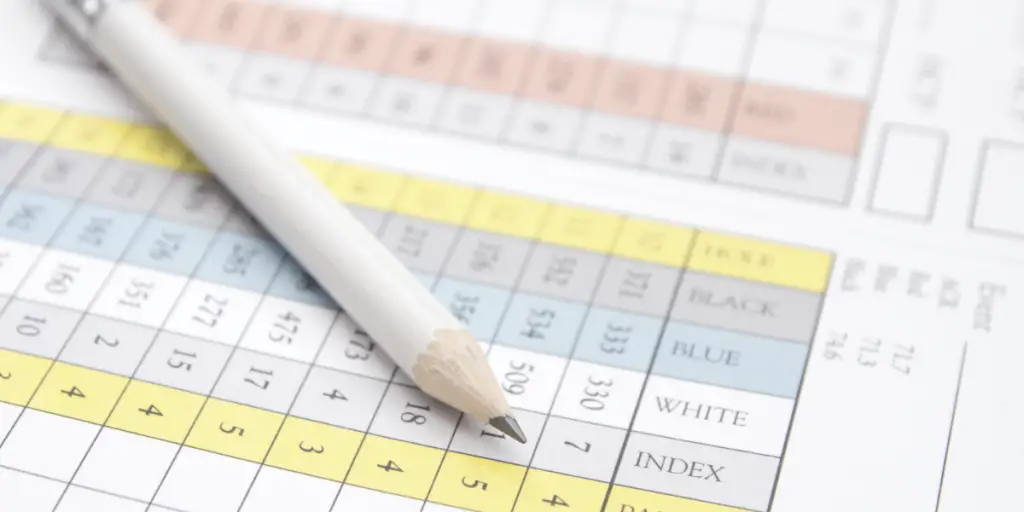Have you ever heard someone say “Yeah, he’s a bogey golfer..” or “That dude is awesome, he’s a scratch golfer!” and were left scratching your head?
What they’re really referring to is how good of a golfer they are and the easiest ways to know how good someone is to find out their “golf handicap”.
What Is A Golf Handicap?
According to the USGA (the governing body for golf in the United States), “a Handicap Index indicates a player’s skill and is a number taken to one decimal place, (e.g., 10.4).”
In addition, it “compares a player’s scoring ability to the scoring ability of a scratch golfer (0 Handicap Index) on a course of standard difficulty.”
So in plain English, a golf handicap is a number indicating your skill level.
The lower your number, the better you are!
Handicap Ranges
Handicaps can range from below 0 to as high as 36.4 for men and 40.4 for women
In the United States, the median male handicap is right around a 13.0 and the median female handicap is right around 25.5.
If you’re a fan of distribution curves, that means about 60% of male golfers fall between a 7.0 and a 19.9 handicap. The top 10% of male golfers are below a 4.9 and the bottom 10% of golfers are above a 23.0.
For women golfers, about 60% fall between a 17.0 and a 34.0 handicap. The top 10% of female golfers are below a 14.0 and the bottom 10% of golfers are above a 39.0.
A scratch golfer is someone with a 0 handicap or the top 1% of all golfers.
Professional golfers who compete on the PGA tour have a handicap of anywhere from +4 to +6.
Why Should I Have A Golf Handicap?
The primary purpose of having a handicap is to allow the game to be more enjoyable by having golfers of varying degrees of skill to compete with one another on a fair basis.
Let’s be completely honest, the probability of a 20 handicap shooting a lower score than a 4 handicap is very unlikely and thus makes competition between the 2 players uncompetitive.
Now suppose the 20 handicap gets a 16 stroke advantage over the 4 handicap, suddenly playing against one another can make things much more interesting.
In addition, many individual golf tournaments allow you take your handicap into consideration when determining your final score.

For example, suppose a golf course of normal difficulty was hosting a tournament with 2 players of varying skill levels.
Let’s say there’s Bob, a 4 handicap and Joe, a 20 handicap. After playing all 18 holes, Bob ends up shooting a final score of 77 and Joe ends up shooting a 91.
When factoring in handicaps, Bob’s “net” score was a 73 (77 final score minus 4 handicap) and Joe’s net score was a 71 (91 final score minus 20 handicap), Joe is declared the winner.
How Golf Handicap Is Calculated
There are 2 main factors that are considered when calculating your handicap; the course difficulty and your scores.
Course Difficulty
Several factors are considered in determining the difficulty of a course and they can be broken down into 2 main categories; length and obstacles.
Length
-
- Roll – how far can a ball roll on full shots. Dryer, firm conditions will have more roll versus wet, soft condition and therefore reduce or increase the overall distance of a course
- Elevation – shots downhill go longer distances than shots uphill and reduce or increase the overall distance of a course
- Dog leg/forced layup – a dogleg is a measure of how much longer or shorter a hole is due to a bend in the hole or because it has obstacles such as water or ravines that force a golfer to hit less than a full shot
- Prevailing wind – if the course is subject to windy conditions, that can dramatically affect the length and direction of golf shots
- Altitude – course located at altitudes 2000 feet above sea level will cause a ball to fly longer and therefore reduce the overall distance of a course

Obstacles
-
-
-
- Topography – similar to elevation, topography also factors mounds and slopes that can lead to uneven or sidehill stances which makes for more difficult shots
- Fairway – this factor takes into consideration the difficulty of keeping the ball in play. Fairway rating takes into consideration width, landing zones, length, trees, obstacles, hazards, and rough difficulty.
- Green Target – how difficult is it to hit the green on an approach shot. Green Target rating considers the size of the green, approach shot length, and overall green conditions.
- Recoverability and rough – this factor measures the difficulty of missing the fairway landing zone and/or green and the ability to recover from it. Green Target plays a large factor in this rating
- Bunkers – factors in the proximity to the target and how difficult it is to recover. Green Target plays a large factor in this rating
- Out of Bounds/Extreme Rough – this measures the distance from the center of the landing zone to the edge of these areas. In these areas, the ball is deemed unplayable.
- Water Hazards – these are evaluated in relationship to the target area and if they need to be played over
- Trees – size and density, factored in with proximity to a target area and the difficulty to recover.
- Green Surface – this is an evaluation of the green from a putting standpoint. Topography and speed are the 2 primary factors.
- Psychological – this is a cumulative effect of all the obstacles factored in and the uneasiness it may cause to a player
-
-
After these 2 categories of difficulty are factored in, there are 2 numbers that measure how difficult a course actually is; course rating and slope rating.
USGA Course Rating
This number is taken to 1 decimal point (e.g. 72.5) and is an evaluation of how difficult a course is for a scratch golfer under normal course and weather conditions. The rating is based on the length of a golf course and other obstacles that directly affect the scoring difficulty of scratch golfers.
The reason for this different standard is that the skill level for a scratch golfer is much higher and therefore, doesn’t face the same difficulty from a similar golf shots for a 20 handicap.
For example, a 125 yard approach shot to a green that’s protected by a water hazard is a more difficult shot for a 20 handicap because of the need to avoid landing in the water.
Slope Rating
This number is a whole number and ranges from 55 to 155 and measures the difficulty of a course for players who are not scratch golfers.
As mentioned earlier, a scratch golfer has a much higher skill level and therefore doesn’t face the same difficulty in an identical shot that a 20 handicap faces.
Bonus – Here are the 5 Highest Slope Golf Courses in the US
-
- Castle Pines Golf Club (Castle Rock, CO), 155 slope
- Clear Creek Golf Club (Carson City, NV), 155 slope
- Pine Valley Golf Club (Clementon, NJ), 155 slope
- Promontory Ranch Club (Painted Valley – Nicklaus course) (Park City, UT), 155 slope
- Rich Harvest Farms (Sugar Grove, IL), 155 slope
Scores
In order to calculate your handicap, you will need at least 5 and up to 20 rounds of 18 holes of golf. Here are the 3 steps to calculate your handicap:
Step 1
For each round you’ll need to calculate your “differential” using the following formula for every round you play:
(Score – Course Rating) x 113* / Slope Rating
For example suppose you shoot an 85 on a course with a 72.5 course rating and 130 slope rating. Your differential for this round would be:
(85 – 72.5) x 113 / 130 = 10.86
* Note: 113 is the average slope for a course and will never change in this formula
Step 2
Figure out how many differentials to use with the following chart:
| Number Of Rounds | Number of Differentials To Use |
| 5-6 | 1 lowest |
| 7-8 | 2 lowest |
| 9-10 | 3 lowest |
| 11-12 | 4 lowest |
| 13-14 | 5 lowest |
| 15-16 | 6 lowest |
| 17 | 7 lowest |
| 18 | 8 lowest |
| 19 | 9 lowest |
| 20 | 10 lowest |
Step 3
Use the following golf handicap formula:
(Sum of Differentials / Number of Differentials Used) x .96
For example suppose you’ve played 20 rounds and you have the following 10 lowest differentials: 10.86, 12.93, 8.54, 12.12, 11.56, 7.54, 9.85, 11.23, 12.54, 9.56.
(10.86+12.93+8.54+12.12+11.56+7.54+9.85+11.23+12.54+9.56=106.73) / 10 = 10.673
10.673 x .96 = 10.2 (drop the number pass the first decimal point, don’t round)
One final note when calculating your handicap. You will, on occasion, have a terrible hole when playing a round of golf.
For example you’re at 3 over par after 11 holes but then on hole 12, the wheels fall off, you hit 2 out of bounds and 3 putt. You end up with an 11 and your round is ruined!
The USGA is forgiving organization (go figure) and wants you to eliminate these anomalies from your handicap calculation. This guideline is called Equitable Score Control or ESC for short. You’ll want to use the following chart to write down your final score:
| Course Handicap | Maximum Score |
| 0-9 | Double Bogey |
| 10-19 | 7 |
| 20-29 | 8 |
| 30-39 | 9 |
| 40+ | 10 |
So in the above example of shooting an 11 on hole 12 and you’re at 10.2 handicap, the highest score you’ll want to take for this hole is a 7.
To find the course handicap visit this site and enter in your current handicap and slope of the course.
What Does This Is Really Mean?
As general rule, on an average difficulty golf course, you’ll normally shoot about 3 strokes above your handicap. Only 25% of the time will you shoot your handicap or better.
For high handicap golfers (20+) on a difficult course with a slope of 130, they might expect to shoot 6-8 strokes above their handicap.
Remember, your handicap is what you’re capable of, not what you average, since it throws out your 10 worst scores out of 20.
Tools To Calculate Golf Handicap
Golf Handicap and Information Network (GHIN)
For those that want to be an official USGA handicap carrying member head on over to the GHIN website to find your local golf association. Once you find your local association, you’ll need to join and become a member to get a GHIN #.
When you have your GHIN #, you’ll then have to create an account so you can post scores to their website. In addition, you could also download the GHIN app from the iTunes store or from the Google Play store and post your scores there as well.

Apps
Swing U
This is one our favorite apps since it has GPS and bunch of other free features built into it.
The free version has access to pretty much every course but you also have the ability to start tracking other stats like fairways hit and putts per hole. By inputting your scores, it’ll start calculating your handicap automatically.
Finally, you’ll have some quick video lessons at your fingertips to help shoot lower scores!
The Grint
With over 37,000 golf courses in it’s database for GPS tracking, The Grint also allows you to track your stats and provides a free “handicap tracker from USGA registered clubs, that are valid for USGA sanctioned events.”
It also has a live tournament scoring feature that allows you to see exactly where you’re at on the leaderboard.
DIY
If you’re a DIY guy like us, here’s a spreadsheet to use for a golf handicap calculator. Don’t forget, you’ll need the rating and slope of the course you played to start calculating your differentials.
Start Tracking Your Scores!
Now that you understand what a handicap is and how they work, it’s time to start tracking yours.
Not only will having data help you track your progress and become a better golfer, but it’ll allow you to have more fun when playing with golfers of all different skill levels.












